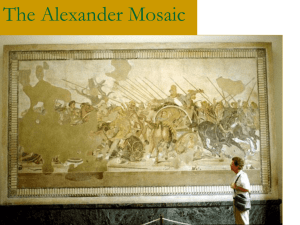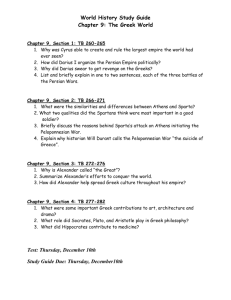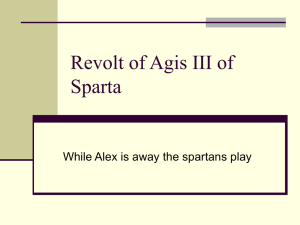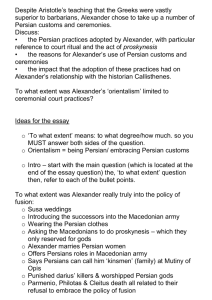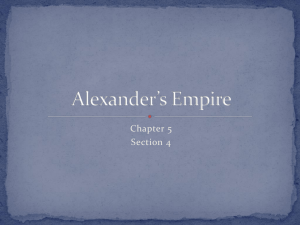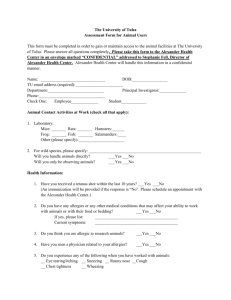BATTLE of GRANICUS Background/Build
advertisement
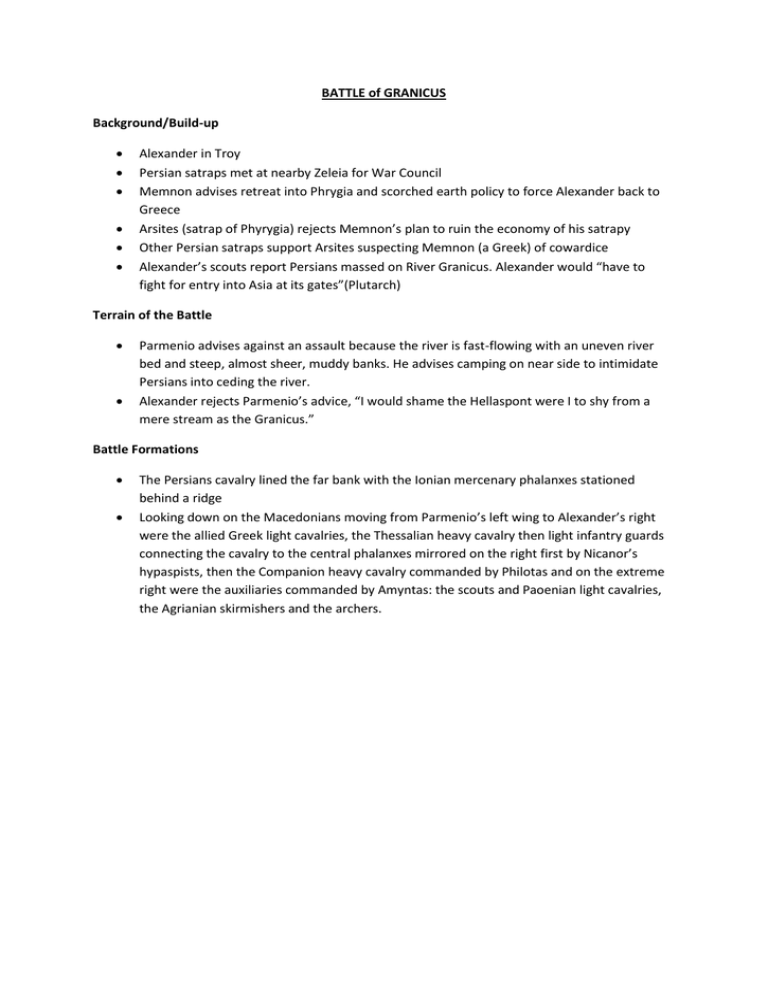
BATTLE of GRANICUS Background/Build-up Alexander in Troy Persian satraps met at nearby Zeleia for War Council Memnon advises retreat into Phrygia and scorched earth policy to force Alexander back to Greece Arsites (satrap of Phyrygia) rejects Memnon’s plan to ruin the economy of his satrapy Other Persian satraps support Arsites suspecting Memnon (a Greek) of cowardice Alexander’s scouts report Persians massed on River Granicus. Alexander would “have to fight for entry into Asia at its gates”(Plutarch) Terrain of the Battle Parmenio advises against an assault because the river is fast-flowing with an uneven river bed and steep, almost sheer, muddy banks. He advises camping on near side to intimidate Persians into ceding the river. Alexander rejects Parmenio’s advice, “I would shame the Hellaspont were I to shy from a mere stream as the Granicus.” Battle Formations The Persians cavalry lined the far bank with the Ionian mercenary phalanxes stationed behind a ridge Looking down on the Macedonians moving from Parmenio’s left wing to Alexander’s right were the allied Greek light cavalries, the Thessalian heavy cavalry then light infantry guards connecting the cavalry to the central phalanxes mirrored on the right first by Nicanor’s hypaspists, then the Companion heavy cavalry commanded by Philotas and on the extreme right were the auxiliaries commanded by Amyntas: the scouts and Paoenian light cavalries, the Agrianian skirmishers and the archers. 1. According to Arrian, the first Macedonian activity was with Amyntas’ auxiliaries. The skirmishers and light cavalries were the first to ford the river and sustained heavy casualties from the Persian archers forcing a partial retreat to rejoin the second wave. 2. Alexander himself led the Companions on an oblique charge across the river (in a reckless and foolhardy manner according to Plutarch). His goal was the Persian centre. His object was to come out of the river in as broad a front as possible. Initially the charge was ineffective as the Macedonians struggled to gain a footing on the muddy banks but the Persian lances were no match against the longer reach of the Macedonian cornel-wood sarissas and Alexander slowly pushed the Persians back far enough for the Macedonians to make a landing. A fierce struggle ensued; “a cavalry battle fought with infantry tactics; man against man and horse against horse.” 3. The rest of the army crossed the river with relative ease because Alexander, clad in his thickly plumed helmet and shining armour, drew the Persian’s focus away from them. X. During the struggle a gap opened up and either Alexander spied the Persian satraps charging at him in wedge formation (Plutarch) or Alexander himself charged in wedge formation at the satraps on the high ground (Arrian). o Arrian and Plutarch differ in the details of exactly what happens next but they agree that Alexander himself personally killed two of Darius’ kinsmen, was nearly decapitated by an axe blow and that Cleitus saved his life by killing a satrap who came up behind the King. 4. Alexander next ordered the mercenary phalanxes surrounded and then massacred. Plutarch says he lost more men in this part of the battle than any other. Aftermath/Consequences Macedonian casualties (according to Arrian) 25 Companions 60 other cavalry 30 infantry Plutarch bases his figure of just 34 on the first-hand account the civilian courtier Arsitobulus Alexander’s treatment of the dead and wounded o He hired his own personal sculptor Lysippus to execute portraits in bronze of the 25 companions to be established at Dium (the hallowed sanctuary of Zeus on the Macedonian slopes of Mt. Olympus). o Families of the fallen were exempted from paying taxes and dues o Soldiers were buried with their arms (armour was expensive – usually recycled) o Visited the wounded and listened to their war stories o Persians and Ionians given permission to collect and bury their dead by their own customs The Prisoners In accordance with the League of Corinth, he sent the captured prisoners (many of them Greek mercenaries) to hard labour in Macedonia for betraying their countrymen by fighting for the enemy of Greece. Greece He also wished Southern Greece to share in his victory and send 300 Persian suits of armour to Athens as an offering to Athena bearing the inscription, “Alexander, the son of Philip, and the Greeks (except the Lacedaemonians) dedicate these spoils taken from the Persians who dwell in Asia.” Persians Many of Darius’ satraps of Asia Minor and other kinsmen were killed. Arsites fled to Phyrgia where he committed suicide. Asia Minor Alexander appointed the Thessalian commander Calas to govern Phrygia and sent Parmenio ahead with to secure Dascylium, which had been abandoned by the Persian garrison. He also gave the town of Zeleia (which has been the Persian headquarters) a full pardon since proclaiming that the Zeleians had been forced to collude with the enemy. His good will towards Zeleia rippled through Asia Minor and other cities like Ephesus quickly surrendered to this merciful king. Battle of Issus Background/Build-up Alexander was first detained in Tarsus having taken a fever from swimming in the glacial river Cydnus and then in Soli where he celebrated the final seizure of Halicarnassus with games. Darius with an army of 600,000 was encamped on the plain of Sochi in Assyria near the Amanic Gates. The Macedonian traitor Amyntas, who had fled to Darius after Alexander acceded the throne, advised Darius to wait for Alexander to seek him out because the plain favoured his superior numbers but Darius allowed himself to be convinced to attack Alexander because his sycophants, who as Arrian says “always are and always will be the bane of kings”, advised him that Alexander was stalling out of cowardice. From his base in Soli in Cilicia, Alexander sent Parmenio ahead with half the army to secure the minor Jonah Pass in case Darius tried to use it. Then he left his wounded at Issus and marched south along the coast towards the Assyrian Gates and Phoenicia. Meanwhile Darius was on the move north to the Amanic Pass; probably knowing that Parmenio held the Jonah Pass. Plutarch says the two armies (Alexander’s moving south and Darius’ moving north; separated by the Amanic Mountains) passed each other in the night. By dawn Darius had come up behind Alexander at Issus and massacred his wounded. Alexander did not at first believe his scouts when they reported that Darius was at Issus, so he sent some of his companions back by sea hugging the coastline in a galley to corroborate the report. When they returned he convened his synedrion (council) where after a rousing speech his companions urged him to lead them onto battle. Alexander fed his army and it passed the night on the rocks of the narrow strip of coastline clad in full armour. At dawn the Macedonians advanced in column until there was room enough for the army to assemble. Terrain of the Battle The site of the Battle of Issus lay a little south of the town of Issus on the little Pinarus river. It is a narrow coastal plain set between the sea and the Amanic Mountains. As the traitor Amyntas had warned Darius, the narrow confines of the place suited Alexander’s smaller army and restricted Darius’ larger one. Arrian refers to the strange geography of the place where the hills arced round on Darius’ left forming a sort of bay, which enabled him to outflank Alexander’s right wing; an advantage that he did not exploit during the battle. Battle Formations The Persians When his scouts reported that Alexander was advancing Darius sent a contingent of cavalry and infantry across the Pinarus to guard against a rapid assault and give him time to array his troops. Looking down on Darius’ army he stationed most of his cavalry on his right. Of the infantry, 30,000 crack Ionian mercenary phalanxes were posted at his centre and supporting these on either side he posted Cardacian heavy infantry numbering 30,000 on either side; 60,000 in all. Reaching into the hills he placed another unit of 20,000 Cardacians. He himself took the traditional place of the Persian kings in the centre behind the Ionians and behind him he massed the rest of his army: a mix of both light and heavy infantry; herded according to ethnic origin. The narrowness of the plain rendered the rear redundant in the battle. Once Darius was ready he recalled the infantry he had sent across the river and ordered half the advance cavalry to join the cavalry on his right wing and the other half into the hills on his extreme left. Once Darius realised however that the slopes were unsuitable for horses he recalled most of the cavalry in the hills and sent them in full view of Alexander to re-enforce his right wing. By now almost all his cavalry was posted on his right wing. The Macedonians Alexander initially took the Thessalian cavalry along with the Companions on his right wing leaving only the allied Greek cavalries to Parmenio’s left but when Darius moved his cavalry from the hills to his over to his right Alexander likewise sent the Thessalians to support Parmenio; only Alexander ordered them to move around in the rear so that Darius would not see what was happening. Looking down on Alexander’s final battle array at Issus and moving form Parmenio’s left wing across to Alexander’s right the Greek allied light cavalries reached from the water’s edge on the beach to connect with the Thessalian heavy cavalry. Craterus’ guards linked the cavalry with the heavy infantry phalanxes of Amyntas, Ptolemy and Meleager. Craterus was in general command of all infantry on the left at Isuss but Parmenio held supreme command of the left wing. Moving on into the right wing, at the centre was stationed first Perdiccas’ phalanx and then Coenus’ was met by Nicanor’s hypaspists, which linked the infantry to the heavy Companion cavalry. These in turn were supported by the Scouts and Paeonians and because of the Persians in the hills on his right Alexander had been forced to split his extreme right wing in two. The far tip inclined at an angle facing the high-ground occupied by the Persians. Here Alexander deployed the Agrianes, a few archer detachments, some mercenary troops and just two squadrons of Companions to keep the Persians in the hills in check. Key moments of the Battle Alexander ordered Parmenio to hold the left wing against the Persain charge and to guard against an out-flanking manoeuvre on the beach. He also warned his extreme right wing to watch the Persians in the hills. 1. Alexander led the right wing cavalry on a charge across the Pinarus smashing the Persian left wing and then turned left and made straight for the Persian centre: the Ionians and Darius. At the same time the Persian cavalry charged across and clashed with Parmenio’s left wing. 2. The phalanxes followed Alexander’s lead but found the gravelly shore difficult to ascend furthermore they were met by the Persian infantry, which made gaining a foothold on the Persian bank doubly difficult. X. A patriotic battle broke out between the Macedonians in the river and the Ionians on the bank with each side trying to out-do the other. The fighting was fierce and the Pinarus ran blood red from the carnage. 3. When Darius saw Alexander charging at him with his Companions his courage failed him and he wheeled his chariot about and fled the battlefield. 4. Once the massed troops in the rear saw their king fleeing they too fled and a general rout ensued. The last units to quit the Persian cavalry who might have broken Parmenio’s left wing had the battle lasted longer. Aftermath Alexander seized Darius’ chariot, bow, shield and cloak as well as his personal treasure of 3,000 talents. Alexander also took Darius’ harem, which included his mother, wife and children into custody He buried the dead with full honours and celebrated the funerals with the full army in parade Alexander was himself injured in the thigh by a blade and although Chares (a Greek courtier of Alexander’s) claimed that it was inflicted by Darius himself Plutarch cites Alexander’s own letters to disprove it. Darius himself fled with 4,000 survivors across the Euphrates into Mesopotamia. 100,000 Persian infantry were killed along with 10,000 cavalry. Many of the Persian satraps that had survived Granicus also now lay dead and Sabaces, the satrap of Egypt was also killed.
